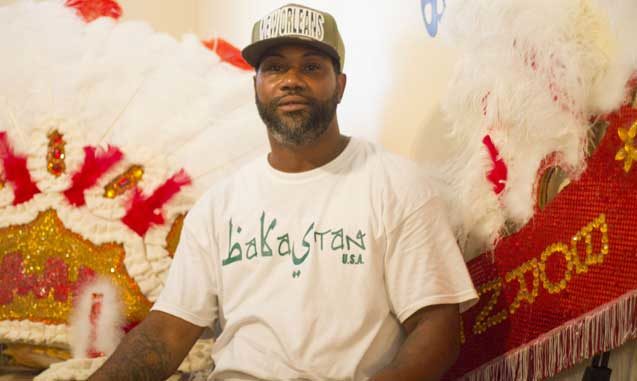
Timeline: 2017- Present – 7Th Ward Hunters Tribe
2004 – 2010 – Young Cheyenne Tribe
Big Chief WAR a.k.a Brick is part of a great legacy in this culture. He was introduced to this culture by his father Verdell “Brick” Sceau and uncles who were in the Cherokee Hunters Tribe. The Cherokee Hunters tribe became the Flaming Arrows after the death Big Chief Clarence “Boy Boy” Guadet. Theodore “Merk” Goodman, original chief of the Flaming Arrows from Back-a-town (back end of the 7thward aka BaKaStan), welcomed their cousins into the tribe. Currently the chief of Flaming Arrow is Kevin Goodman the son of “Merk”. Big Chief Kevin Goodman and Brick were part of the first all-children tribe called the Young Flaming Arrows which was 15-20 deep in members—and all positions had Queens. Many of the newer tribes forming since the late 70’s early 80’s came from the Young Flaming Arrows tribe, especially as it relates to downtown tribes. Speaking with Chief Brick about how the 7th and 6th ward tribes have developed and are connected is like listening to Neil deGrasse Tyson speak about our solar systems evolution. This interview, 14 weeks into our 42 tribe series, is very much educational. Truly every chief has their own story or journey. I’m finding through my learning and understanding of the culture that it’s an ever-evolving life form with seemingly endless branches.
Q) What are your thoughts on the difference between uptown and downtown beading?
A) “Some look at this like its uptown style. I can’t agree with that. You got all kind of downtown Indians that wore this before they were calling it any kind of style. It was creative art. Uptown, downtown, all around town it’s what they wore. The original Indian suit was creative art. Creative art was flat patches. Three dimensions is when it sticks out and all that. Everybody that wore an Indian suit back in the day wore creative art, so there’s no such thing as uptown or downtown styles. “
Q) What was the benefit of masking as a child?
A) “The culture I come up in was if you didn’t sew you didn’t mask. That’s why we like to start them off young from my experience. It was homework, good grades and we had a shed on Frenchman (I just seen they put a house or something there now). We had twenty to thirty kids everyday with adults showing us how to do hats, and we were dying white marabou purple. They were showing us this, and we had a workshop because when we came from school we couldn’t do none of this. All of us sat at the table and did homework. There were like twenty of us. There was a long table with twenty to thirty kids. That same table we did homework on we converted that into a workshop with Indian suits. We couldn’t just mask to say we mask, we had to put our hands on it.”
Q) Without that table available for youth today, who is teaching the youth?
A) “I don’t see too many all-kids tribe but you do have a lot of kids that are part of the culture and another thing I have notices, more and more kids are learning to dance, to sing, to sew, to build their own stuff. That’s the thing I love about them. Like I said, there aren’t a lot of kid tribes but there are a lot of kids that mask with some of these tribes that are learning the right way. When you are playing Indian and you meet an Indian you have to be taught to play a certain way. You can’t just let a kid go out there and develop a style because it could be a wild style he develops. When I say that, I mean it’s a disrespectful style. But I see a lot of kids posting stuff on Indian world. They sitting there sewing, Lil biddy kids teaching them how to sing. So it’s there we just have to do more of it. We have to do more of it.”
Q) What are your thoughts on the labels of Indian, Mardi Gras Indian or Black Masking?
A) “The word Indian is really insulting to a lot of people. It’s really disrespectful to people. It’s like calling a blacks a nigga. A real true native don’t want to be called an Indian because they know where they come from. That’s kind of why, we in the black masking world are going to use black masking and other terms cause the Mardi Gras Indian thing just played out. That’s a term we were given just like African-American. You see what I’m saying, feel me? We have to get away from that. We not Mardi Gras Indians. Y’all are commercializing us by saying that but y’all won’t give us any of the commerce.”
Q) What does W.A.R. stand for and is that the spirit of your tribe?
A)” Willing and Ready, that’s the acronym. I look at everything I do, I take it head on. Willing and ready to means life will throw some things at you. You got to be willing to accept what it throws,and you got to be ready to take the consequences. Do or die, win or lose. This Indian thing is the same thing. I have cried a many of mornings late, not thinking I’m going to make it. One morning I didn’t make it. This is passion, blood sweat and tears. This is something you have to prepare for like an athlete. The same way an athlete prepare his body like a boxer prepare his skills. These beads not going to jump on there (the suit).
WAR is the spirit I become Mardi Gras morning. I’m not Brick no more, I’m not Keith no more, none of that. When I paint my face, whatever color… red and I put these feathers in my head. When I walk out my door and I sing Indian red I transform. I’m a whole other person. Like my ancestors, all of them I am aligned with come in me. You might see my eyes roll in the back of my head like I’ve caught the Holy Ghost. That’s what it is. That’s what it feels like. I never actually caught the Christianity type but I always catch this Holy Ghost. It’s like an ancestral thing that comes over me, that’s the war spirit that enters me.
Recommended For You.



Be the first to comment